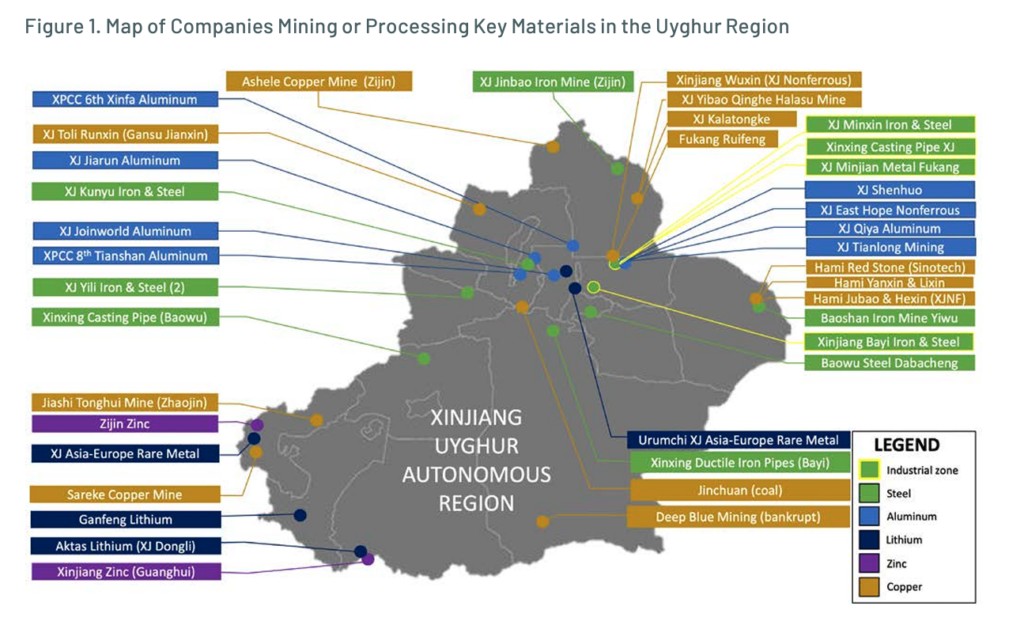It might be unsettling to consider, but there’s a significant chance that components in your vehicle are linked to forced labor. If you own a car from brands like Volkswagen-Audi, Honda, Ford, General Motors, Mercedes-Benz, Toyota, Tesla, Renault, NIO, or Stellantis, the risk is even higher. These vehicles may contain parts sourced from companies connected to human rights abuses in the Xinjiang Uygur Autonomous Region (XUAR) of China, an area now under scrutiny due to the Uyghur Forced Labor Prevention Act (UFLPA).
These alarming conclusions are drawn from a comprehensive report, “Driving Force,” published in December 2022 by researchers at Sheffield Hallam University (SHU). This report meticulously examines automotive supply chains and the prevalence of forced labor within the XUAR. The findings suggest a deeply concerning reality: “…practically all parts of the car are exposed to Uyghur forced labor in one way or another.” This exposure spans from raw materials like steel, aluminum, and copper to essential car parts such as hood ornaments, braking systems, tires, seat padding, batteries, and electronic components.
The report’s revelations prompted immediate action, with the US Senate Finance Committee launching a formal investigation targeting major global automakers. This article will delve into the crucial findings of the SHU report, discuss the ongoing US Senate Finance Committee probe, and explore the necessary steps automakers must take to ensure ethical sourcing and build more resilient Car Parts Chains.
Key Findings Exposing the Car Parts Chain and Forced Labor
China’s dominance as a global auto parts supplier is no accident; it’s a strategic objective. The automotive parts manufacturing market is projected to reach almost US $2 trillion by 2026, and China is aggressively pursuing a larger share. The “Made in China 2025” initiative prioritizes transforming China into a “world manufacturing power,” with a strong focus on the automotive and car parts industries.
This strategic plan is yielding results. In 2021, China’s auto parts exports exceeded US $45 billion, with the U.S. automotive industry importing US $11.5 billion of these parts.
 A map of the Xinjiang region highlighting the locations of companies involved in mining or processing key materials for car parts chain.
A map of the Xinjiang region highlighting the locations of companies involved in mining or processing key materials for car parts chain.
A map illustrating the Uyghur Region and the concentration of mining companies categorized by materials crucial for car parts chain production: steel, aluminum, lithium, zinc, and copper. Source: “Driving Force” report, 2022.
The XUAR is central to this success. The Chinese government has actively incentivized companies to relocate raw material processing, particularly for iron and steel, to the XUAR, where regulatory oversight is lax. The “Made in China 2025 Xinjiang Action Plan” explicitly states the government’s ambition to expand the automotive industry within the region and to elevate XUAR-based car parts brands to national and international recognition.
These initiatives are intertwined with state-sponsored “labor transfer” programs in the XUAR. Millions of residents are coerced into labor-intensive industries under the constant threat of internment and imprisonment, a practice likened to modern slavery. The SHU report’s key findings underscore the drive towards utilizing the Uyghur region and these forced labor programs within the car parts chain.
The report’s critical findings include:
- 96 companies involved in mining, processing, or manufacturing materials essential for car parts operate within the XUAR; at least 38 of these have documented involvement in state-sponsored labor transfer programs.
- Over 40 automotive manufacturers in China source materials or parts from the XUAR or from companies participating in labor transfers.
- More than 50 international auto parts or car manufacturers directly source from companies operating in the XUAR or those accepting transferred laborers.
- Over 100 international auto parts or car manufacturers are estimated to have some level of exposure to goods produced with Uyghur forced labor within their supply chains.
For a detailed visual representation of the automotive supply chain vulnerabilities, explore this interactive network map from SHU to trace the connections between automakers and the XUAR, from raw material extraction to specific car manufacturers and parts distributors, revealing the intricate car parts chain.
US Senate Finance Committee Investigates Forced Labor in the Car Parts Chain
Following the SHU report, Senator Ron Wyden, Chair of the Senate Finance Committee, initiated an investigation, sending letters to eight major automakers: Ford, General Motors, Honda, Mercedes-Benz, Stellantis, Tesla, Toyota, and Volkswagen. Wyden asserted, “Unless due diligence confirms that components are not linked to forced labor, automakers cannot and should not sell cars in the United States that include components mined or produced in Xinjiang.”
Wyden demanded detailed information from automakers regarding supply chain mapping for raw materials, mining, processing, and parts manufacturing, specifically requesting data on any products detained by U.S. Customs and Border Protection under the Uyghur Forced Labor Prevention Act (UFLPA). The initial responses from automakers were deemed insufficient by the Senate Committee, lacking detailed explanations of how corporations monitor their extensive car parts chains to prevent forced labor. Automakers often deflected responsibility, stating that suppliers were accountable for ensuring ethical labor practices.
In March 2023, Wyden expanded the investigation, issuing further inquiries to automakers and tier-1 suppliers. He emphasized, “I recognize that tier-1 suppliers rely on complex supply chains to source thousands of parts from across the world. However, this complexity cannot cause the United States to compromise its fundamental commitment to upholding human rights and U.S. law.” This second phase included the original eight automakers and major tier-1 suppliers like Continental AG, DENSO Corporation, Magna International Inc., Roberts Bosch GmbH, and ZF Friedrichshafen AG, all integral to the car parts chain.
For deeper insights into the investigation, refer to Resilinc’s special report, Leading Automakers Probed for Potential Ties to Forced Labor, which further elucidates the scrutiny on the car parts chain.
Automakers’ Responsibility: Addressing Forced Labor in the Car Parts Chain
As investigations continue under the UFLPA, automakers face increasing pressure to sever ties with forced labor. The SHU report provides crucial recommendations. Firstly, automakers must meticulously map their car parts chains, tracing raw materials, mining, processing, and manufacturing within the XUAR. They should not assume any part of their supply chain, including sub-tier suppliers, is free from forced labor links. Adherence to the UN Guiding Principles on Business and Human Rights is essential, prioritizing the identification of XUAR links within their car parts chain.
Upon discovering any connections to the region, companies must terminate contracts and relationships with implicated suppliers and systematically exit the XUAR at every level of their car parts chain as swiftly as possible. To foster transparency and shared knowledge, companies should publicly disclose findings of XUAR links within their supply chains and announce decisions to end supplier relationships. The report further recommends that car companies collaborate with raw materials industries to implement reparations for populations exploited in the XUAR.
Resilinc advises automakers to initially assess Tier-1 suppliers operating in the XUAR. A thorough examination of the bill of materials for all goods and parts is crucial to understand the depth of the car parts chain. Gathering documentation from suppliers across all tiers, including customs entry documents, finished goods documentation, proof of payment, and transportation records, is also recommended.
Resilinc highlights warning signs that may indicate supplier links to the XUAR:
- Operations within or near internment camps, prisons, or industrial parks.
- Discrepancies between high revenue and low employee contributions to government social security insurance.
- Non-standard hiring practices, such as utilizing government recruiters.
Resilinc’s Solutions for a Transparent Car Parts Chain
Resilinc empowers companies to conduct thorough due diligence by providing enhanced visibility into the complex sourcing process of the car parts chain. Resilinc’s Multi-Tier Mapping solution enables automakers and suppliers to map their supply networks down to the n-tier, uncovering hidden risks within the car parts chain. Leveraging 12 years of supplier-validated data, this comprehensive approach offers unparalleled insights compared to conventional methods.
Resilinc can pinpoint suppliers within an organization’s car parts chain that operate in the XUAR, identify parent entities based in the region, or detect sanctioned suppliers. This n-tier visibility allows companies to identify and vet alternative suppliers, crucial for building a resilient and ethical car parts chain. Gaining comprehensive visibility through supply chain mapping is the essential first step for automakers and car parts suppliers committed to mitigating forced labor in their operations and constructing a responsible car parts chain.
To explore how Resilinc delivers supply chain visibility, learn more about Resilinc’s Multi-Tier Mapping solution and its application to strengthening the car parts chain.
